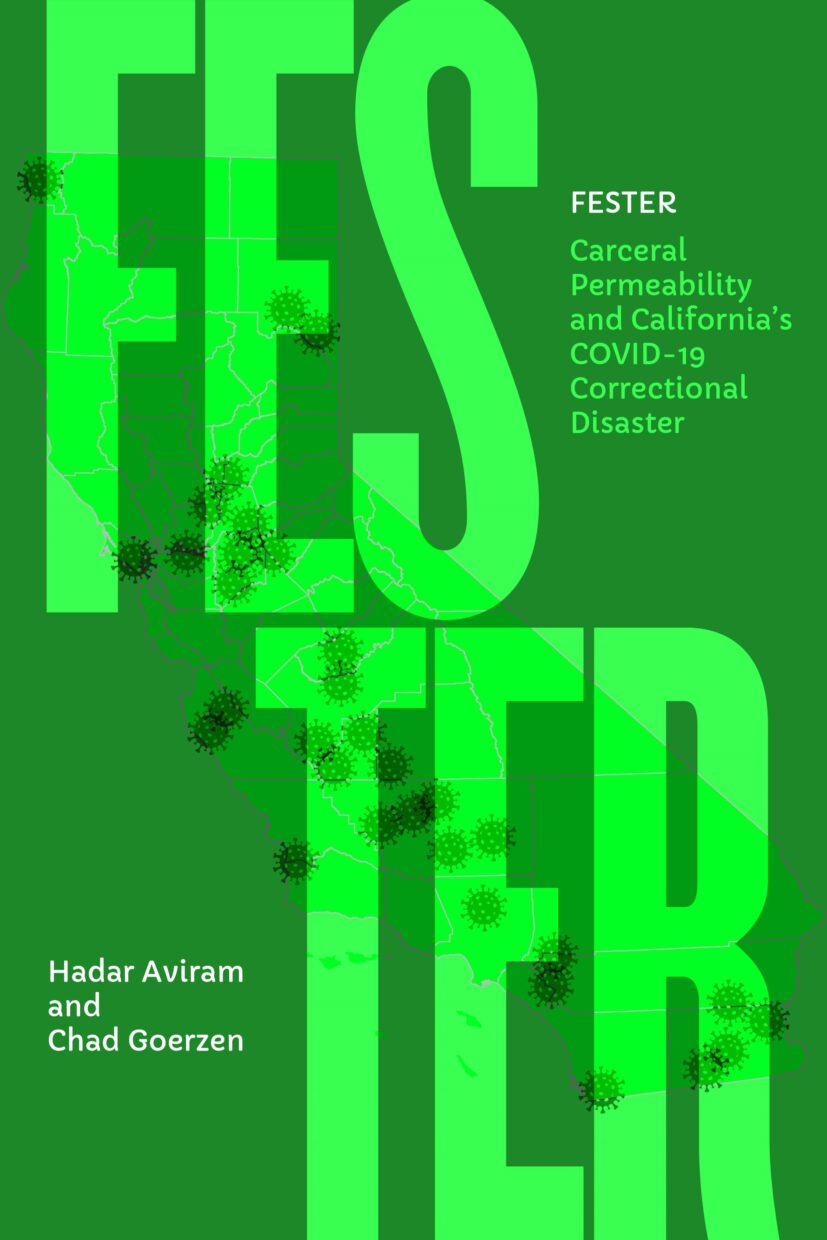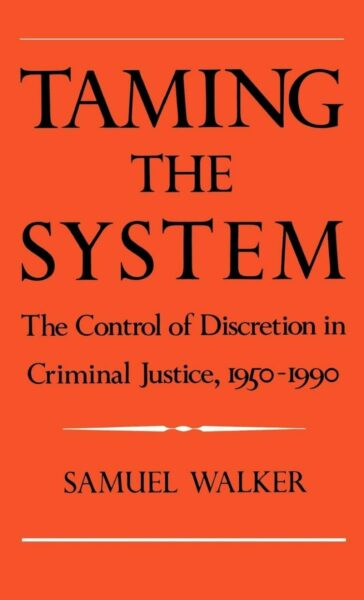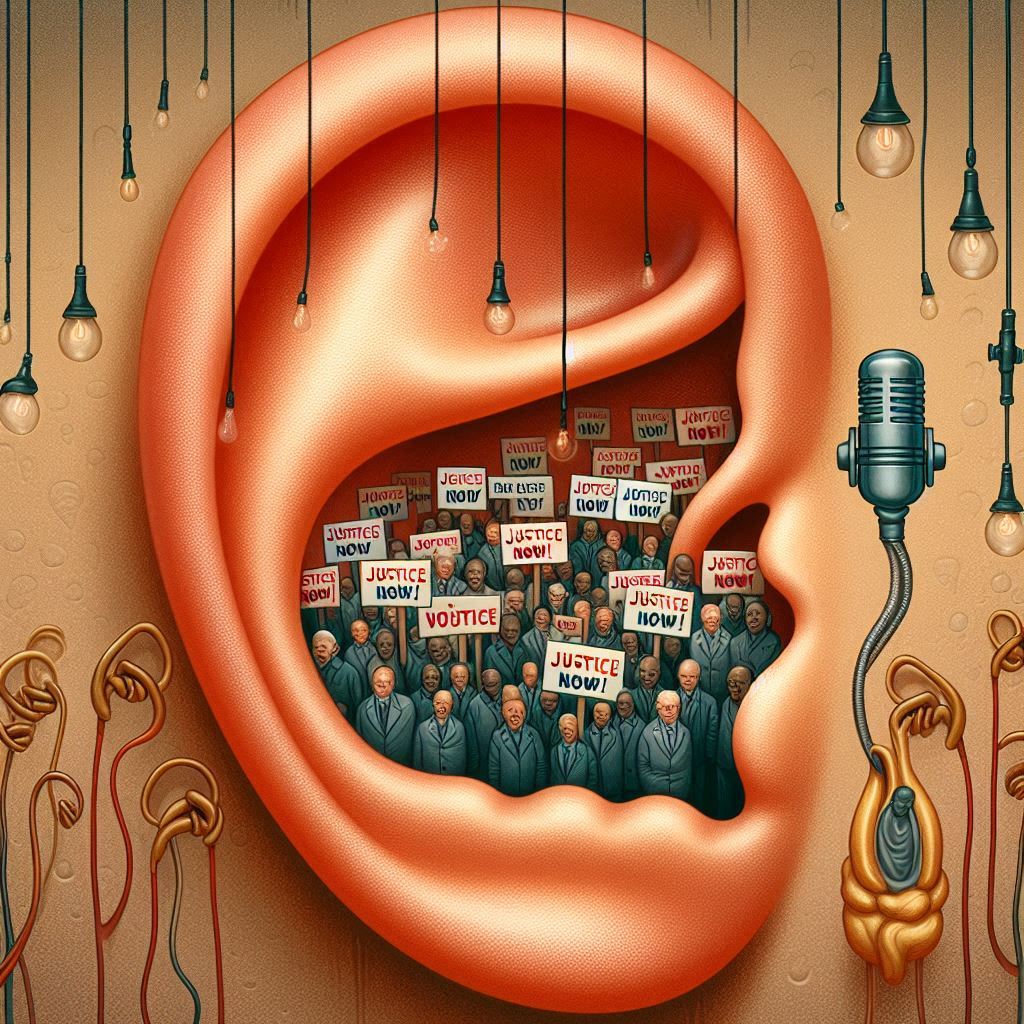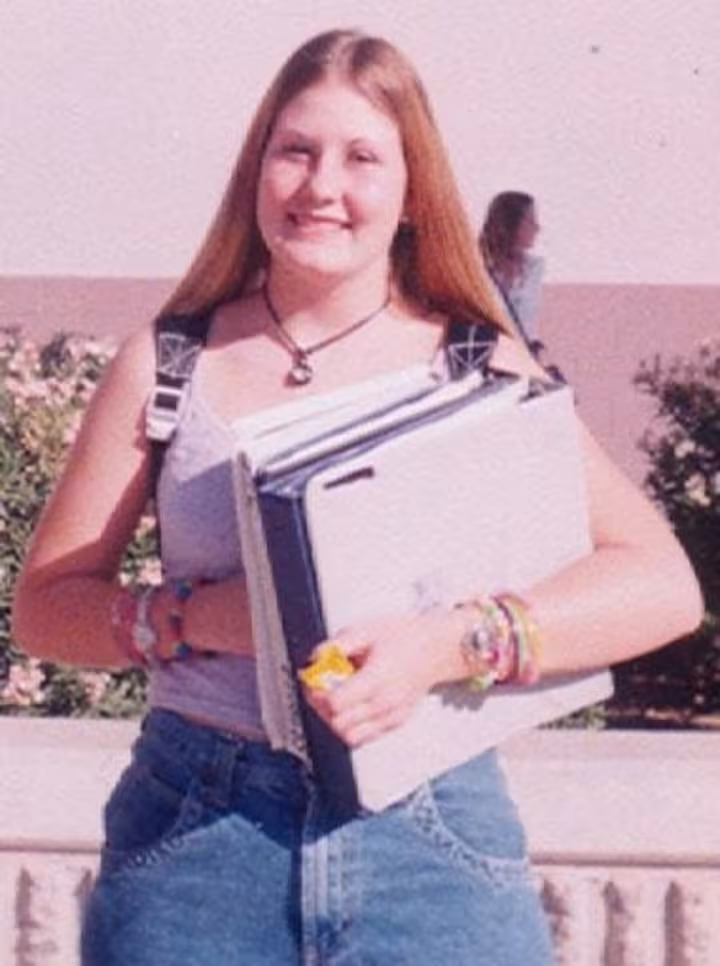One of the most notable effects of democratization through podcasting platforms is that not only can families get involved and active in supporting podcasts about their tragedies–they can become podcast producers themselves. One of the most notable examples in this space is Sarah Turney, producer and host of the successful podcast Voices for Justice and an activist for cold case resolution and forensic testing.
Sarah’s interest in true crime is personal: on May 17, 2001, her sister Alissa (in the above photo, taken by Sarah)–who had finished her junior year in high school that very day–disappeared, and the podcast was Sarah’s effort to reinvigorate the police investigation of what she came to believe was a no-body homicide. The last person to see Alissa, by his own admission, was Michael Turney (Sarah’s father and Alissa’s stepfather; he married Alissa’s mom when she was three years old, and she died when Alissa was nine, leaving him as a single parent to six children, the youngest of whom is Sarah). Michael reported picking Alissa up from school and arguing with her, after which she stormed off. Later, Michael and Sarah found a note in Alissa’s room, according to which she was going to California, but she left her personal belongings, including her cell phone, behind.
For the first few years after her disappearance, Alissa was regarded by the police as a runaway; it was only in 2006 that the investigation was altered to view her as a missing person. During the early years, Michael reported having received a brief phone call from Alissa, during which she swore at him and then ended the call.
In 2008, federal agents raided Michael’s home in search of evidence implicating him in Alissa’s disappearance, but they found something completely different and alarming in its own right: the largest cache of working bombs, weapons, and other explosives, ever found in the hands of an individual. Along with these items, they found a lengthy, rambling manifesto, in which Michael claimed that Alissa was murdered by assassins from his union, the International Brotherhood of Electric Workers, against whom he had grievances related to his employment. The bombs and weapons were part of his plan to blow up the union’s building.
Michael was charged for possession of the bombs in federal court, and his stalwart supporter was his daughter, Sarah, who was 13 years old when Alissa disappeared and by now was a young adult. Sarah helped Michael organize his defense even as she reeled from the shock of the federal evidence. But gradually, as she followed the case, Sarah came to see Michael in a different light, considering for the first time that he might have had something to do with Alissa’s disappearance. When she carefully floated this theory with her older brothers and other relatives, she was surprised to find out that most of them were convinced of his guilt and had plenty of stories to tell about his bizarre, sometimes menacing, behavior.
After thoroughly revisiting many incidents from her childhood, Sarah contacted the police department, urging them to revive the investigation into her sister’s disappearance. In 2017, she was reportedly told by a detective that the only way to prompt the police to make progress was to apply media pressure–and she did exactly that. Sarah launched her own podcast, Voices for Justice, in 2019, and in 2020 began posting on Tiktok, quickly acquiring a large audience.
The first thirty episodes of the podcast are devoted to a chronology of the family’s history, highlighting Michael’s odd behavior. Sarah highlights his uncaring behavior toward his wife–Sarah’s mother, who died of cancer–and even implies that he might have hastened her death. As to his other children, especially Alissa, Michael was depicted as exhibiting controlling and menacing behavior, which included festooning the family home with surveillance cameras, recording phone calls, closely scrutinizing Alissa’s activities and relationships, and fashioning strange “contracts” regarding Alissa’s behavior that he made her sign (including, bizarrely, a statement that “[m]y father, Mike Turney, has never physically or sexually abused me at any time.”) Sarah also analyzed several instances in which Michael said things, or behaved in ways, that suggested an inappropriate sexual interest in Alissa, and some off-hand comments from Alissa herself about his being a “pervert” which suggested sexual abuse. Michael exhibited unreasonable hostility toward the idea of Alissa having a boyfriend, and increasingly described her, after her disappearance, as having severe learning disabilities and thus requiring close surveillance–a description that Sarah contends is unfounded and untrue. During one confrontation, Michael told Sarah that he would tell her the truth about Alissa on his deathbed.
In 2020, the podcast had its desired effect: after almost 20 years, Michael Turney was arrested and charged with the murder of his stepdaughter. Sarah paused her reporting of the case, pivoting the podcast to highlighting other unsolved murder and disappearance cases (usually devoting an episode or two to each case). In her dual capacity as a family member and podcaster, she has advocated for ethical reporting of true crime; while acknowledging that true-crime podcasts are “entertainment”, she has urged fellow creators to be sensitive to the concerns of victims, and the public to be mindful of theories and speculations they spew in forums discussing true-crime new media.
Michael’s trial, however, ended on a different note. Dateline NBC summarizes the trial and its aftermath:
Jurors in that Phoenix courtroom heard five days of testimony from witnesses in the state’s case — including two Phoenix Police Department detectives, Stuart Somershoe and William Andersen, and Alissa’s boyfriend at the time of her disappearance, Jonathan Laakman.
The state rested their case on the sixth day of the trial — Monday, July 17 — after two days of testimony from Det. William Andersen. At that time Michael Turney’s defense attorneys, Jamie A. Jackson and Olivia Hicks, submitted a motion to the judge for an acquittal, citing Rule 20 of the Arizona Rules of Criminal procedure, which states that “the court must enter a judgment of acquittal… if there is no substantial evidence to support a conviction.”
Defense attorney Olivia Hicks argued that the state did not present any physical evidence that Alissa Turney is dead and their client caused her death. In response to the defense’s motion, Deputy County Attorney Vince Imbordino told the judge that Alissa Turney had been a 17-year-old girl with family and friends, prized possessions and she would have been in contact if she had been alive.
Judge Sam Myers ruled in favor of the defense and the jurors were relieved of their duty. All charges in the case against Michael Turney have been dismissed and he was released from custody on Tuesday, July 18.
Turney is now suing the police department and the prosecution, though he could not find a lawyer to take the case.
Sarah promises to produce an in-depth serial podcast providing more information about the case, as well as her take on the trial (this will be released, if I understand correctly, as the second season of another podcast produced by Sarah, Media Pressure, whose first season was devoted to the disappearance of Maura Murray, a long-time cause célèbre of true crime followers.) I was unable to follow the trial closely, and am therefore far from an expert on the minutiae of the evidence presented and how similar–or different–it was from the evidence offered in the podcast (by contrast to Chris Lambert in Paul Flores’ trial, Sarah attended Michael’s trial as Alissa’s sister, rather than as a member of the press, and therefore obviously did not report on the progress of the trial), so I don’t want to speculate. There are, however, some remarkable features to the interface of media and police investigation here, that I think are notable.
The first one is that the police itself insinuates that investigative progress is contingent upon public interest and pressure–“squeaky wheel gets the grease,” if you will. This has a few effects on the field of true crime podcasting, some positive and some negative. For every case that goes viral in the new media arena, there are thousands of unsolved cases equally deserving of assiduous investigation that will not receive attention if the criterion for progress is media pressure. It’s true that the availability (and democratization) of the podcast medium means that victim families are not dependent on networks or professional producer to share their stories with the public; Sarah’s is an example of a family member taking control of the narrative around their loved one’s disappearance or murder, and she is facilitating a similar journey for Maura Murray’s sister Julie. Still, not every family member will have the wherewithal, journalistic chops, storytelling talent, and practical means to draw attention to their case so effectively, and the police statement on the importance of media pressure implies that such arbitrary issues will set police priorities.
Second, and relatedly, the proliferation of true crime podcasts, some seeking to replicate the success of Serial and other early examples and some to draw attention to specific cases, raises the risk of market saturation. If all cases are important, I worry that no case will be important, and these cases will produce diminishing returns in investigations and prosecutions.
Third, for a lay audience (or even for legal professionals who are not up to date with case technicalities) it is hard to judge whether a podcast that reflects dogged, detailed journalistic work–Sarah’s is certainly that, and over its first thirty episodes mines an incredible amount of family videos, documents, and objects, as well as testimonies and conversations–has marshaled the kind of evidence that will be (1) admissible and (2) persuasive in court. A podcast, like a documentary, is not an unvarnished reflection of the messy reality: it is a work of art that tells a story, and even if the storyteller aims at being as objective as possible in assessing the strength of the evidence, it will provide a certain framing. The medium’s immersive qualities will absorb listeners, who will later be surprised and disappointed that the story does not play out in court the way it played out in the podcast. A podcast doesn’t feature cross-examination; there is no counternarrative, nor is there a concerted effort to highlight the gaps in the story (and even if there is, people will focus on what they hear rather than on what they don’t).
Fourth, unfortunately, there is the fact that even devoted prosecutors will never care as much about the minutiae of a murder case as the victim’s family. Incidents that come to loom large in the minds of loved ones might not occupy as large a place for a prosecutor trying to tell a concise, limited story, over a limited number of days, to twelve strangers who are not engaging with the narrative out of free choice. There’s a classic law and society paper by Austin Sarat and William Felstiner called “Law and Strategy in the Divorced Lawyer’s Office”, in which they show how lawyers hear their clients tell a complicated, painful family story and reduce it to what is and is not legally relevant. A podcast wants to tell us the former; a legal proceeding is going to sift through it to produce the latter. It will, by necessity, not be as engaging and absorbing as a moving story told by the people who care about it the most.
I don’t know all the details of how, and why, the charges against Michael Turney were dismissed; no-body homicides are notoriously difficult to prosecute, as the main piece of forensic evidence–the body–is missing. I look forward to hearing Sarah Turney’s take on the case. But I do think that it is important, for both creators and audience, to be clear-eyed about the fundamental incompatibilities between media and investigation, no matter how much the people in charge of the latter encourage families to utilize the former.











